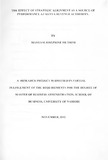| dc.description.abstract | Effective organizations are organic, integrated entities in which different units, functions
and levels support the company strategy. As a result, coherence or alignments on these
organizational entities have an impact on the performance of these organizations.
Organizational strategic alignment requires a shared understanding of organizational
goals and objectives by managers at various levels and within various units of the
organizational hierarchy. This is because a firm's ability to seek and maintain a
competitive advantage rests on its ability to acquire and deploy resources that are
coherent with the organization's competitive needs. The purpose of the study was to
establish the effect of strategic alignment on organizational performance at Kenya
Revenue Authority.
The research design was a case study aimed at establishing the effect of strategic
alignment on performance at Kenya Revenue Authority. The target population consisted
of respondents deemed to be knowledgeable of the effect of strategic alignment on
organizational performance. Data collection was based on both primary and secondary
sources. An interview guide was used to collect data from the respondents. Content
analysis was used to analyze the qualitative primary data which had been collected by
conducting interviews. Secondary data was collected from organizational records.
The findings of the study were that KRA has developed strategies that are designed to
enhance performance through the four perspectives of the Balanced Score Card.
Policy implication for strategic alignment is that the level of strategic alignment and
organizational performance are closely related. Kenya Revenue Authority management
can clearly identify organizational goals during a strategic alignment initiative thereby
achieving organizational performance. Future research should consider the role of time,
contextual factors, various employer representatives and their role as sense-givers in any
strategic alignment initiative. | en |

